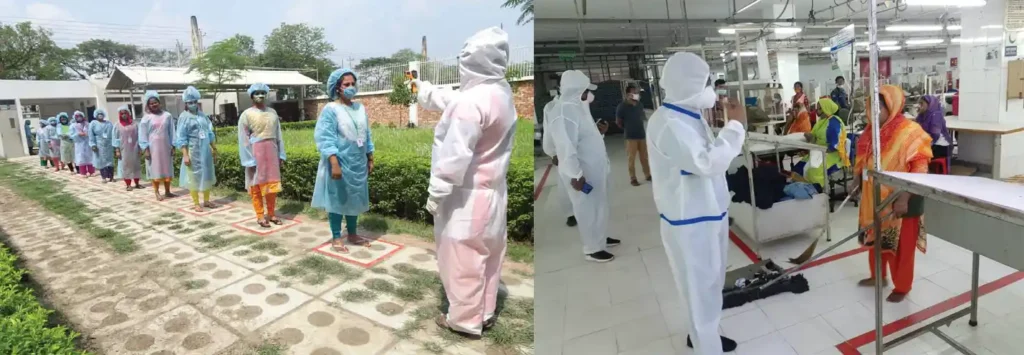The Covid-19 pandemic sent shockwaves across all industries, but few were hit as hard as the garment sector. Bangladesh, a global powerhouse in garment manufacturing, faced unprecedented challenges that forced the industry to adapt and innovate quickly. If you’re part of the fashion industry, an apparel brand, a buyer, or a fashion retailer, understanding these impacts is crucial for navigating the post-pandemic landscape.
Introduction
Bangladesh is not just another player in the global garment industry; it’s a pivotal one. The country ranks as the world’s second-largest garment exporter, contributing significantly to its GDP and employing millions. However, when Covid-19 struck, it caused a seismic shift in this critical sector. This blog post will walk you through how the pandemic impacted Bangladesh’s garment industry, from the immediate fallout to long-term implications. Along the way, you’ll discover how the industry adapted and what the future may hold.
The Pre-Pandemic State
Before the pandemic, Bangladesh’s garment industry was flourishing. The country was home to over 4,000 garment factories that supplied to major brands like H&M, Zara, and GAP. This thriving sector contributed to about 84% of Bangladesh’s total exports, making it the backbone of the economy.
The industry employed approximately four million workers, most of whom were women. The steady flow of international orders kept factories buzzing and economies growing. However, this success story had its complexities. Issues like labor rights, factory safety, and wages often made headlines, but the sector continued to grow, driven by high demand for affordable clothing.
In this golden era, Bangladesh had been working on improving conditions and standards to attract even more international clients. Certifications like the Accord on Fire and Building Safety had started to make a difference, increasing Bangladesh’s competitiveness in the global market.
The Immediate Impact of Covid-19
When Covid-19 hit, the immediate impact was devastating. International orders were abruptly canceled or postponed as global demand plummeted. Factories were forced to shut down, leaving millions of workers without jobs. The economic repercussions were severe, affecting not only the garment workers but also their families and communities.

The sudden halt in operations led to an estimated $3 billion worth of canceled orders, plunging the industry into a financial crisis. Many small and medium-sized enterprises (SMEs) couldn’t survive the sudden economic downturn and had to close their doors permanently.
Workers faced dire consequences. With no income, many struggled to afford basic necessities. The lack of social security nets in Bangladesh exacerbated the situation, leaving the workforce vulnerable to extreme poverty.
Adaptations and Innovations
In the face of this crisis, the garment industry in Bangladesh had to adapt quickly. One of the most significant shifts was in production. Factories pivoted to produce personal protective equipment (PPE), including masks and gowns. This move not only kept some factories operational but also contributed to the global fight against Covid-19.
Supply chain management underwent a transformation as well. With international logistics disrupted, local sourcing gained importance. Factories started to prioritize domestic materials and suppliers to reduce dependency on international shipments.
Worker safety became a focal point. Factories implemented stringent health protocols to ensure the well-being of their employees. Measures such as social distancing, frequent sanitization, and health screenings became standard practice, allowing some level of operations to continue even during lockdowns.
“In Bangladesh, we have seen a lot of improvements in the workplace, compliance building, as well as in structural standards & sustainability.”
Deepak DSOUZA, Country Manager, Decathlon Bangladesh.
In April 2020, amid the pandemic, the ILO backed a Global Call to Action to support manufacturers and protect workers’ income, health, and employment. This initiative sought to develop sustainable social protection systems for a more equitable and resilient garment industry. With the sector lacking a social safety net, the government intervened with a $600 million stimulus to safeguard workers’ salaries.
To achieve equal partnerships within the supply chain, there needs to be a shift in buyer-supplier relationships and improved purchasing practices. Enforcing government-backed due diligence in consumer countries could be part of the solution. Additionally, maintaining safety and social compliance progress in Bangladesh’s garment industry is crucial, with a collective code of conduct for manufacturers being necessary.
The crisis highlighted the need for stronger, safer, and more resilient supply chains. Social dialogue among suppliers, buyers, and workers’ representatives is essential to minimize financial harm and ensure resilience. The shift to digital wage payments during the pandemic has promoted financial inclusion, showing efficiency and effectiveness over cash-based systems. This digitization plays a critical role in advancing financial security and inclusion, especially for vulnerable populations, such as the 55-60% of the RMG workforce who are women. Digital and financial inclusion are key to women’s economic empowerment, exemplifying the principle of ‘building back better.’

Long-Term Implications
The long-term implications of Covid-19 on Bangladesh’s garment industry are multi-faceted. One of the most notable changes is the shift in consumer behavior. The pandemic accelerated the trend towards online shopping, forcing brands and suppliers to adapt quickly. Digital transformation became a necessity rather than an option.
Consumer demand also shifted towards more sustainable and ethical fashion. Brands began to scrutinize their supply chains more closely, prioritizing transparency and ethical practices. This shift has led to increased pressure on Bangladesh’s garment industry to improve labor conditions and environmental standards.
Recovery remains a challenge. While some factories have resumed operations, the industry is far from its pre-pandemic levels. However, the crisis has also opened up opportunities for innovation and improvement. Investment in technology, sustainable practices, and worker welfare could pave the way for a more resilient and competitive industry in the future.
Conclusion
The Covid-19 pandemic has undoubtedly reshaped Bangladesh’s garment industry. From the immediate economic fallout to long-term shifts in consumer behavior and industry practices, the impacts are profound. However, this crisis has also highlighted the resilience and adaptability of the industry.

